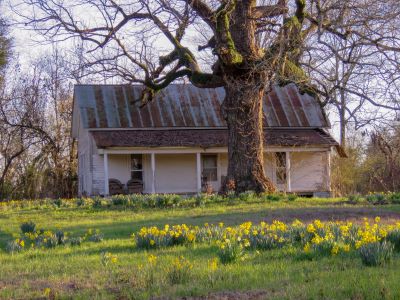
The Song of the Blue Bottle Tree takes place in the country around the Great Bend of Red River in southwestern Arkansas. All locations in the book are real, one way or the other.
Cypress Lake is a false name for what was my father’s favorite duck hunting area back in the 1940s and 1950s. Since it is a spectacular and vulnerable ecosystem, I relocated it for the purposes of the story. The lake and surrounding countryside are private property. Country boys didn’t pay much attention to no trespassing signs in mid-century Hempstead County, and many of my father’s stories center around slipping in and out of the place with his best friend. My uncle had his own stories of anxiously waiting with the getaway car on a deserted county road. Though they observed the game limits, outrunning the game warden was even better sport than duck hunting, so they enthusiastically evaded him every chance they got.
Mercer Bayou is an old channel of the Sulphur River in Miller County. Since it is too far from Washington for literary purposes, I established its twin in Hempstead County and called it Bois d’Arc Bayou. Arkansas Game and Fish Commission undertook an extensive renovation of Mercer Bayou in recent years, restoring a beautiful body of water surrounded by cypress and frequented by white egrets and other water birds. The pier is real; the community rowboat is a figment of my imagination.
A state park encompasses Washington, featuring beautifully restored 19th century buildings and a long list of public events. My grandfather went to school in the big brick building on the hill. Near by is the restored blacksmith shop where James Black built the first Bowie knife. My great-aunt Myrt’s house has been renovated and put on the tour list. Both the giant magnolia and the oak trees bedecked with resurrection ferns are real and easy to find. The famous Jonquil Festival in March celebrates the yellow flowers that brighten the yards and roadways of the community each spring. For more information, see https://www.arkansasstateparks.com/parks/historic-washington-state-park.
Once a thriving community, modern Columbus consists of a post office, and a handful of private residences. The business district was razed decades ago. Older houses have fallen down, been torn down, or moved to Historic Washington State Park.
Both Columbus and Washington fell victim to the Cairo and Fulton Railroad which was built between Little Rock and Fulton in the early 1870s. The first passenger train arrived at Hope Station in 1872; three years later, the town of Hope was incorporated about ten miles southeast of Washington. Businesses gradually relocated to the new town, and the older communities dwindled.
All the cemeteries in the book are real places where I’ve spent many peaceful hours reading obscure headstones. I am related by blood or marriage to over three quarters of the folks buried in Columbus Cemetery. The Pioneer Cemetery in Washington contains the eternal resting place of Rebecca Ellen Pate, born 1831, died 1848. I discovered her grave the year I turned fifteen. I still visit her whenever I’m in the area even though she isn’t much of a conversationalist. Rebecca’s reticence triggered the idea for Blue Bottle Tree. I thought, “What if she did have something to say to me?” and the seeds of what eventually became Genevieve Charbonneau took root.
The two farms mentioned in the book are based on my family farm near Columbus. It started out as a working farm with a big garden, a double row of apple trees, a small herd of cattle, and a bunch of chickens. After my parents sold the last cow in 2000, they harvested the trees on the place, then left it alone to grow the next crop of tree. The Ives farm mirrors my farm in its heyday. Lela Hughley’s farm reflects the condition of my farm after the second growth trees swallowed most of the old landmarks. The land just to the north once belonged to my great-grandfather. Somewhere in the pasture is the old pit where he dug clay to make bricks for the chimney and well house.
The beautiful five-span open spandrel arched bridge that spanned Red River at Fulton was replaced in 1982 by a modern, efficient, boring bridge. The original bridge, located on Highway 67, features prominently in my family history, but that’s a blog for another day.
